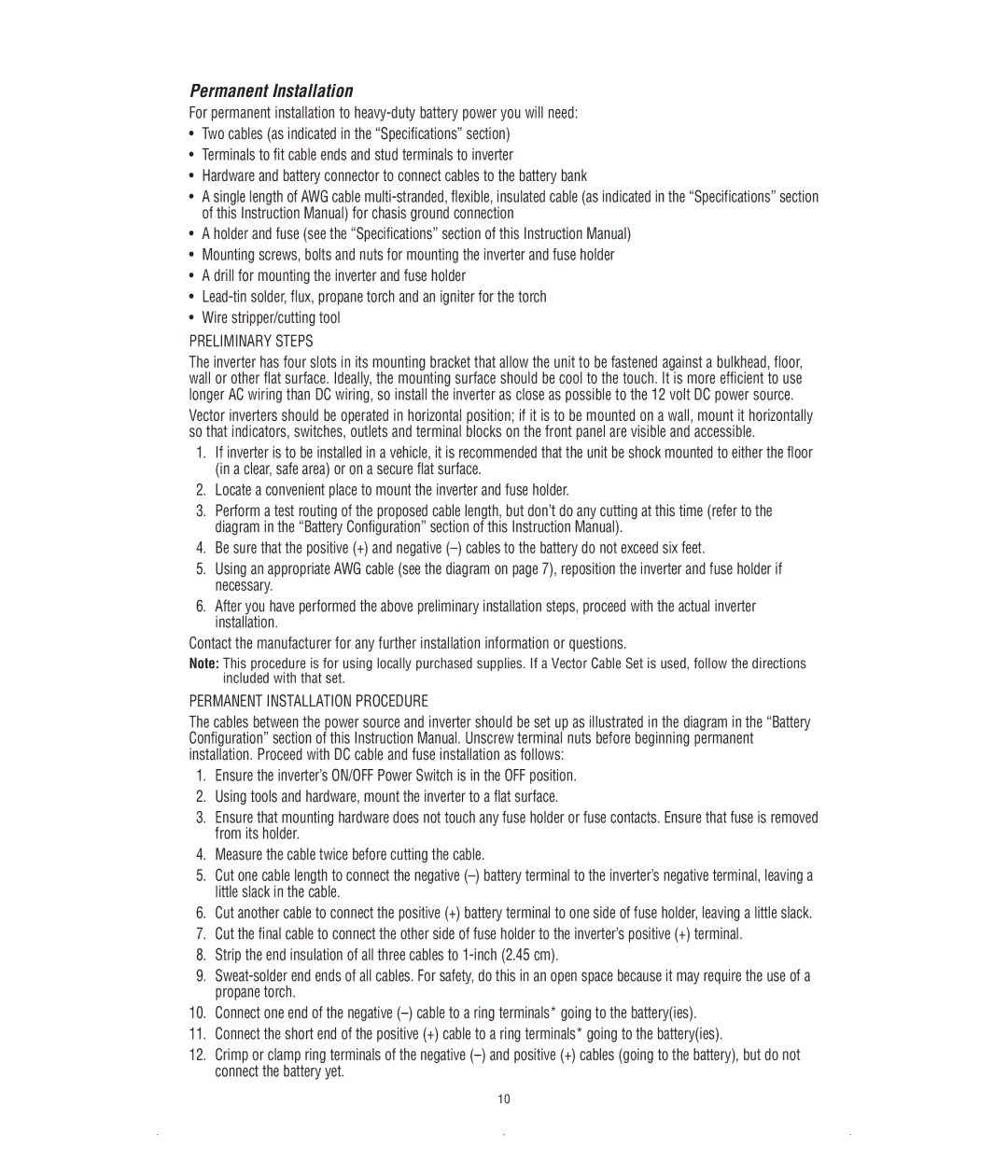
Permanent Installation
For permanent installation to
•Two cables (as indicated in the “Specifications” section)
•Terminals to fit cable ends and stud terminals to inverter
•Hardware and battery connector to connect cables to the battery bank
•A single length of AWG cable
•A holder and fuse (see the “Specifications” section of this Instruction Manual)
•Mounting screws, bolts and nuts for mounting the inverter and fuse holder
•A drill for mounting the inverter and fuse holder
•
•Wire stripper/cutting tool
PRELIMINARY STEPS
The inverter has four slots in its mounting bracket that allow the unit to be fastened against a bulkhead, floor, wall or other flat surface. Ideally, the mounting surface should be cool to the touch. It is more efficient to use longer AC wiring than DC wiring, so install the inverter as close as possible to the 12 volt DC power source.
Vector inverters should be operated in horizontal position; if it is to be mounted on a wall, mount it horizontally so that indicators, switches, outlets and terminal blocks on the front panel are visible and accessible.
1.If inverter is to be installed in a vehicle, it is recommended that the unit be shock mounted to either the floor (in a clear, safe area) or on a secure flat surface.
2.Locate a convenient place to mount the inverter and fuse holder.
3.Perform a test routing of the proposed cable length, but don’t do any cutting at this time (refer to the diagram in the “Battery Configuration” section of this Instruction Manual).
4.Be sure that the positive (+) and negative
5.Using an appropriate AWG cable (see the diagram on page 7), reposition the inverter and fuse holder if necessary.
6.After you have performed the above preliminary installation steps, proceed with the actual inverter installation.
Contact the manufacturer for any further installation information or questions.
Note: This procedure is for using locally purchased supplies. If a Vector Cable Set is used, follow the directions included with that set.
PERMANENT INSTALLATION PROCEDURE
The cables between the power source and inverter should be set up as illustrated in the diagram in the “Battery Configuration” section of this Instruction Manual. Unscrew terminal nuts before beginning permanent installation. Proceed with DC cable and fuse installation as follows:
1.Ensure the inverter’s ON/OFF Power Switch is in the OFF position.
2.Using tools and hardware, mount the inverter to a flat surface.
3.Ensure that mounting hardware does not touch any fuse holder or fuse contacts. Ensure that fuse is removed from its holder.
4.Measure the cable twice before cutting the cable.
5.Cut one cable length to connect the negative
6.Cut another cable to connect the positive (+) battery terminal to one side of fuse holder, leaving a little slack.
7.Cut the final cable to connect the other side of fuse holder to the inverter’s positive (+) terminal.
8.Strip the end insulation of all three cables to
9.
10.Connect one end of the negative
11.Connect the short end of the positive (+) cable to a ring terminals* going to the battery(ies).
12.Crimp or clamp ring terminals of the negative
10
